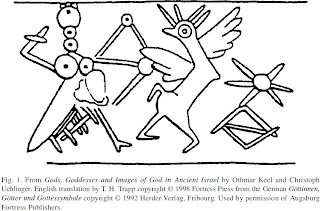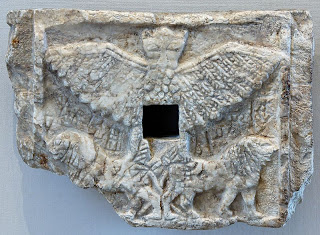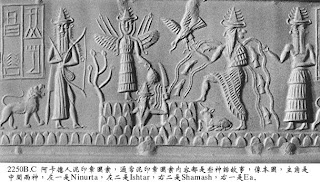 Senth century BCE cylinder seal found in Israel depicting the battle of Ninurta and Anzu. Nili Wazana, in a brilliant exposition on Anzu and Ziz asks and tentatively answers the question: "Were the Israelites acquainted with the Epic of Anzu?" She cites this rendering of a seventh century BCE cylinder seal portraying the battle of Ninurta and Anzu, discovered in Israel. http://www.jtsa.edu/documents/pagedocs/janes/2009/wazana_janes31.pdf
Senth century BCE cylinder seal found in Israel depicting the battle of Ninurta and Anzu. Nili Wazana, in a brilliant exposition on Anzu and Ziz asks and tentatively answers the question: "Were the Israelites acquainted with the Epic of Anzu?" She cites this rendering of a seventh century BCE cylinder seal portraying the battle of Ninurta and Anzu, discovered in Israel. http://www.jtsa.edu/documents/pagedocs/janes/2009/wazana_janes31.pdf Zu or Anzu (from An'heaven' and Zu'to know' in Sumerian language), as a lion-headed eagle, ca. 2550–2500 BCE, Louvre. Votive relief of Ur-Nanshe, king of Lagash, representing the bird-god Anzu (or Im-dugud) as a lion-headed eagle. Alabaster, Early Dynastic III (2550–2500 BCE). Found in Telloh, ancient city of Girsu. H. 21.6 cm (8 ½ in.), W. 15.1 cm (5 ¾ in.), D. 3.5 cm (1 ¼ in.)
Zu or Anzu (from An'heaven' and Zu'to know' in Sumerian language), as a lion-headed eagle, ca. 2550–2500 BCE, Louvre. Votive relief of Ur-Nanshe, king of Lagash, representing the bird-god Anzu (or Im-dugud) as a lion-headed eagle. Alabaster, Early Dynastic III (2550–2500 BCE). Found in Telloh, ancient city of Girsu. H. 21.6 cm (8 ½ in.), W. 15.1 cm (5 ¾ in.), D. 3.5 cm (1 ¼ in.)Ancient Near east Anzu, falcon-shaped fire-altar Uttarakhand, turning aṁśú (Rigveda), ancu (Tocharian) in smithy.
The seventh century BCE cylinder seal found in Israel, is paralleled in an Akkadian cylinder seal.
 “On the mountainside Anzu and Ninurta met … Clouds of death rained down, an arrow flashed lightning. Whizzed the battle force roared between them.“ Anzu Epic, tablet 2,in S. Dalley, Myths from Mesopotamia (Oxford - New York, 1989), p. 21. One narration reads: Marduk, sun god of Babylon, with his thunderbolts pursues Anzu after Anzu stole the Tablets of Destiny. Note: The tablets of destiny may be a reference to Indus writing corpora which were veritable stone-, mineral-, metal-ware catalogs.
“On the mountainside Anzu and Ninurta met … Clouds of death rained down, an arrow flashed lightning. Whizzed the battle force roared between them.“ Anzu Epic, tablet 2,in S. Dalley, Myths from Mesopotamia (Oxford - New York, 1989), p. 21. One narration reads: Marduk, sun god of Babylon, with his thunderbolts pursues Anzu after Anzu stole the Tablets of Destiny. Note: The tablets of destiny may be a reference to Indus writing corpora which were veritable stone-, mineral-, metal-ware catalogs.As a researcher on ancient Hindu civilization a contribution was made by me in Journal of Indo-Judaic Studies, Vol. 1, Number 11 (2010) -- The Bronze Age Writing System of Sarasvati Hieroglyphics as Evidenced by Two “Rosetta Stones” By S. Kalyanaraman. The 'rosetta stones' were two pure tin ingots discovered in a shipwreck in Haifa and with Indus writing. The Indus writing on these tin ingots have been read rebus as denoting 'tin' (mineral) which was in demand to be used to alloy with copper to create bronze, thus replacing the naturally-occurring but rare arsenic-copper minerals and heralding a true bronze age.
According to Louis Renou, the immense Rigvedic collection is present in nuce in the themes related to Soma. Rigveda mentions amśu as a synonym of soma. The possibility of a link with Indus writing corpora which is essentially a catalog of stone-, mineral-, metalware, cannot be ruled out.
George Pinault has found a cognate word in Tocharian, ancu which means 'iron'. I have argued in my book, Indian alchemy, soma in the Veda, that Soma was an allegory, 'electrum' (gold-silver compound). See: http://bharatkalyan97.blogspot.in/2011/10/itihasa-and-eagle-narratives.html for Pinault's views on ancu, amśu concordance.
The link with the Tocharian word is intriguing because Soma was supposed to come from Mt. Mujavant. A cognate of Mujavant is Mustagh Ata of the Himalayan ranges in Kyrgystan.
Is it possible that the ancu of Tocharian from this mountain was indeed Soma?
The referemces to Anzu in ancient Mesopotamian tradition parallels the legends of śyena 'falcon' which is used in Vedic tradition of Soma yajña attested archaeologically in Uttarakhand with a śyenaciti, 'falcon-shaped' fire-altar.
http://bharatkalyan97.blogspot.in/2011/11/syena-orthography.html śyena, orthography, Sasanian iconography. Continued use of Indus Script hieroglyphs.
Comparing the allegory of soma and the legend of Anzu, the bird which stole the tablets of destiny, I posit a hypothesis that the tablets of destiny are paralleled by the Indus writing corpora which constitute a veritable catalog of stone-, mineral- and metal-ware in the bronze age evolving from the chalcolithic phase of what constituted an 'industrial' revolution of ancient times creating ingots of metal alloys and weapons and tools using metal alloys which transformed the relation of communities with nature and resulted in the life-activities of lapidaries transforming into miners, smiths and traders of metal artefacts.
I suggest that ayas of bronze age created a revolutionary transformation in the lives of people of these bronze age times.
Kalyanaraman
July 29, 2013
Comparing the allegory of soma and the legend of Anzu, the bird which stole the tablets of destiny, I posit a hypothesis that the tablets of destiny are paralleled by the Indus writing corpora which constitute a veritable catalog of stone-, mineral- and metal-ware in the bronze age evolving from the chalcolithic phase of what constituted an 'industrial' revolution of ancient times creating ingots of metal alloys and weapons and tools using metal alloys which transformed the relation of communities with nature and resulted in the life-activities of lapidaries transforming into miners, smiths and traders of metal artefacts.
I suggest that ayas of bronze age created a revolutionary transformation in the lives of people of these bronze age times.
Kalyanaraman
July 29, 2013
